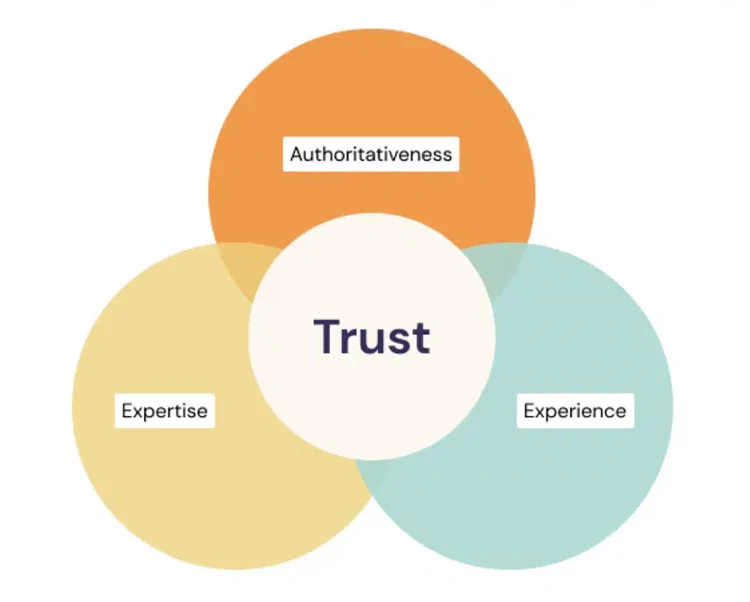
What is E-E-A-T?
E-E-A-T stands for Expertise, Experience, Authoritativeness, and Trustworthiness. It’s a set of principles Google’s search quality raters use to determine the credibility of a web page. Out of these aspects, trust is the most important.
Google first introduced what was then known as E-A-T back in 2014 to evaluate web content’s overall quality and credibility; the second “E”, for “Experience”, was added in December 2022.
As digital marketers, we advise on and integrate E-E-A-T best practices wherever possible. This helps boost websites’ authority in the eyes of Google, which can then translate to better rankings and traffic. A combination of SEO services and Content services, getting E-E-A-T optimized on your site is a must in today’s search landscape.
Breaking Down Each of the E-E-A-T Principles

Technically, any content published on a website should be optimized for Google’s E-E-A-T requirements, but this is especially true on informative content such as blogs, articles, and FAQs over commercial pages.
To demonstrate compliance with E-E-A-T, brands should focus on each of the four components: Expertise, Experience, Authoritativeness, and Trustworthiness; Google has tried to relate those principles to actual technical elements/parameters on a website.
Experience refers to whether you, as a content creator or brand publisher, have any first-hand or life experience required for the topic.
Expertise relates to the author’s (or publisher’s) skill level and/or knowledge on the subject.
Authoritativeness is the extent to which the publisher/creator or brand is respected & well-established within the industry on the topic.
Trustworthiness deals with the accuracy, honesty, safety, and reliability of the overall website/brand.
Here is a great example of content optimized for E-E-A-T from Bankrate. They have included the following indicators:
- Clear publishing date and updated date, if applicable
- Clear details on who wrote, edited & reviewed such content
- Prominent information about article authors with details on their expertise and links to social media profiles
- Disclaimer that highlights editorial standards

How to implement E-E-A-T on your site
Some general recommendations to address E-E-A-T requirements are as follows:
- Expertise / Experience / Authoritativeness: Add a disclaimer that highlights editorial standards and explains how you prepare/publish content
- Trustworthiness: Add all dates relevant to this content: published date, edited date, updated date, reviewed date
- Trustworthiness/Expertise: Add information about the writer, editor, or reviewer so one can always trace back to a human
- Expertise / Experience / Authoritativeness: Enrich the article author’s page with a headshot, in-depth details on their expertise, qualifications & links to social media profiles
- Enhance the relevant structured data and schema markup on all articles, news & author.
| Tactic | Expertise | Experience | Authoritativeness | Trust |
|---|---|---|---|---|
| Add a disclaimer that highlights editorial standards and explains how you prepare/publish content. | X | X | X | |
| Add all dates relevant to this content: published date, edited date, updated date, reviewed date. | X | |||
| Enrich the article author’s page with a headshot, in-depth details on their expertise, qualifications & links to social media profiles. | X | X | X | |
| Choose content that you can write about authoritatively; don’t “reach.” | X | X | ||
| Include sources for stats, reports, and data. | X | X | ||
| Display accessible contact information about your company/customer service (footer, menu link, etc..) | X | |||
| Display third-party reviews on your website. | X | |||
| Post case studies showcasing clients’ success stories. | X | X | X | |
| Earn coverage, mentions & backlinks from other respected sites that focus on the same industry/topic. | X | X | ||
| Invite or get quotes from expert / recognized figures on the topic. | X | |||
| Have an extensive depth of content pieces on the same / surrounding topics. | X | X |
Does E-E-A-T apply to all brands and websites?
E-E-A-T is particularly critical for websites and brands that fall under the YMYL (Your Money or Your Life) category. Google considers any such content to be one that may directly impact a person’s health, financial stability, safety, and happiness and could potentially impact a user’s financial stability or well-being. Hence, Google needs to ensure that only the right publisher, brand, and content gets shown to users.
Is E-E-A-T a ranking factor for SEO?
No, E-E-A-T is not a direct ranking factor in Google’s algorithm. The best way to describe E-E-A-T is that it closely aligns with signals that would affect ranking factors. As such, we should pay attention to it the same way one looks at all ranking factors contributing to SEO performance.
Optimizing for E-E-A-T can indirectly improve a site’s search performance over time.
So, why does it matter to SEO?
By focusing on E-E-A-T in its guidelines, Google aims to surface the most reliable, trustworthy, and valuable content for any user query. These signals form part of the guidelines that human search raters use to evaluate the performance of the ranking algorithm.
However, remember that Google’s main recommendation to content creators always remains true: create helpful, reliable, people-first content!
